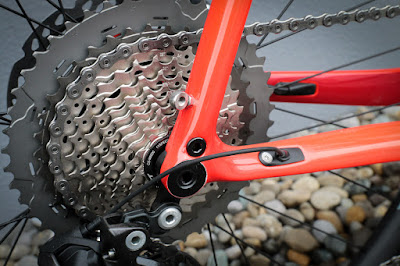by Igor
With the trickle down of disc brakes into bikes of any and all sorts, our inbox has been deluged with questions about fender mounting and compatibility.
The requirements of being an easily fender-able disc brake bike is the same as any bike with rim brakes:
1) Clearances - Your frame should have reasonable clearances around the chain stays and seat stays, and your fork should have sufficient vertical and lateral clearance.
 |
| https://vintagebicycle.wordpress.com/2014/04/24/alex-singer-sportif-chrome-c-1980/ |
Pro tip: Before a long climb, move your water bottle from your cage to your jersey pocket. You'll climb faster due to less weight on the bike. Discuss in comments.
2) Bridges - In order to have an easy time of mounting, both your seat stay and chain stay bridges need to exist - bonus points if they have threaded braze-ons that point towards the wheel.
If your bike does have a bridge but it isn't drilled, use a p-clamp!
We've noticed a lot of contemporary cyclo-cross bikes are bridge-less for mud clearance and comfort over rough terrain. While it is possible to mount a fender using a kludge of hardware, it isn't ideal and it certainly isn't elegant.
 |
| https://www.cxmagazine.com/tom-price-trek-boone-cyclocross-bike-2015-austin-win/4 |
Alas, many manufacturers have forgone eyelets on their performance offerings, though some lucky few offer removable ones. I never understood this. If you're going to drill and tap the frame for a stud for a removable eyelet, why not include it in the casting/mold? It would look intentional and simple.
 |
| https://www.bikerumor.com/2017/09/04/eb17-ibis-flies-radar-new-hakka-mx-gravel-bike-prototype/ |
For the frame, there is typically minimal finagling. This is especially true if the caliper is located within the rear triangle like our frames feature. For caliper located on top of the seatstay, you'll have to play it by ear since the size, shape, and location of the caliper may necessitate bending the stay.
The front is a bit trickier. The caliper, for the most part, sits in the same place for almost all forks. Simply bending the stay vertically around the caliper should provide enough clearance for the brake to operate normally. Some forks, like our Pass Hunter, simply offer a higher mounting point to get around the issue. It isn't the most traditional looking, but it functions perfectly fine. The Polyvalent has a braze-on underneath the dropout for regular fender mounting.
If this isn't possible, you'll need a fat stack of spacers to clear the caliper. Plastic fenders that use two stays typically require this.









9 comments:
No, to your last question, but ha,ha to "less weight on the bike." That's almost as funny as the balloon airbag helmet Bicycling magazine brought out over 40 years ago.
It's worth mentioning that Velo Orange single strut aluminum fenders will clear a front disc brake much easier than typical two strut versions found on plastic fenders.
https://www.flickr.com/photos/jon_baler/40160466351/
https://www.flickr.com/photos/jon_baler/21761566064
https://www.flickr.com/photos/jon_baler/9089909584
I say trickle down economics don't work.
@Turdis,
More of a joke than anything else.
-Igor
When I was putting mudguards on a bike with a Shimano roller brake (mounts to a disk brake braze-on, so equivalent for this discussion) I used the mid-fork lowrider rack mounts, which worked fine and looked ok, I think. That was a bike with 26" wheels though, maybe not an option with 700c/650b.
Also if I was going with the bent stay solution shown, I'd definitely bend the other side to match, especially on the front.
Great tip on the water bottle. You can save even more weight by drinking the water. Or kool-aid of you prefer that.
Drink the water and save the weight of bottle and cage.
Product trickle-down (from more-expensive levels to lower-priced levels) is a totally different mechanism from the one supposed by trickle-down economics (money given back to higher income brackets benefits lower income brackets).
I understand the attempt at a joke, but it falls flat to people who understand the economics.
Tim Cupery, Professor of Sociology, Fresno State University
P.S. I'm a big fan of VO's work, which is why I'm reading the blog.
@Tim,
You're correct. I understand the mechanism behind trickle-down economic theory (graduated with a degree in Economics), it was joke that unfortunately sounded better in my head as I was writing it.
Also, thanks for the kind words! Happy riding!
-Igor
Post a Comment